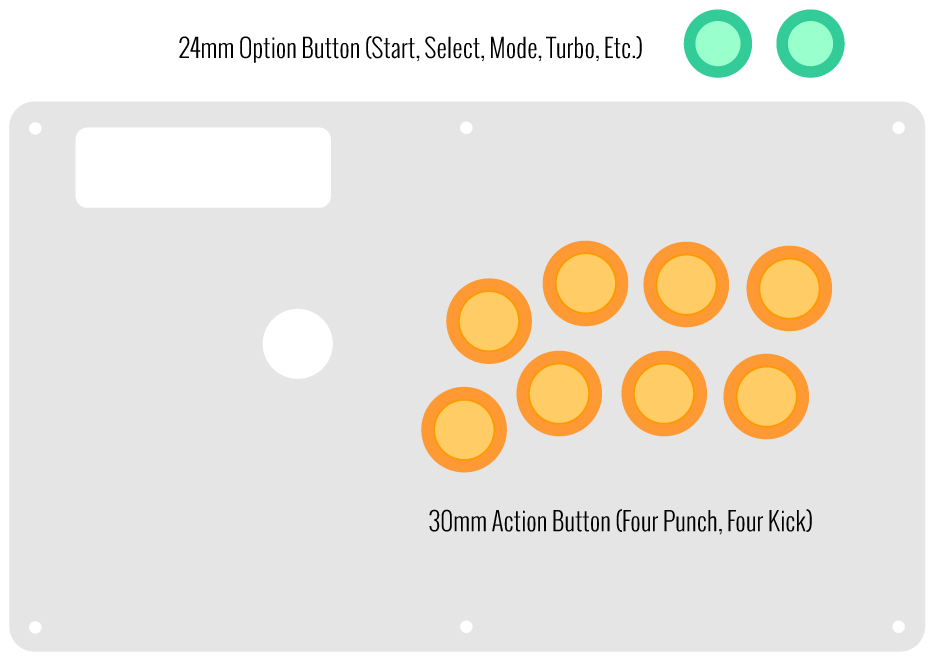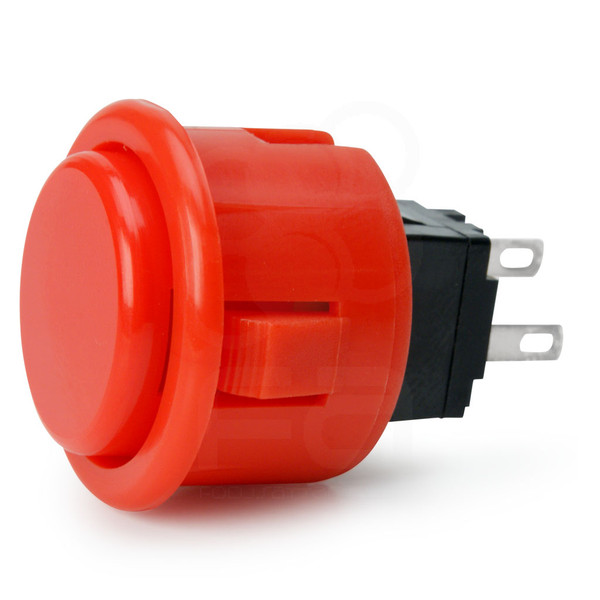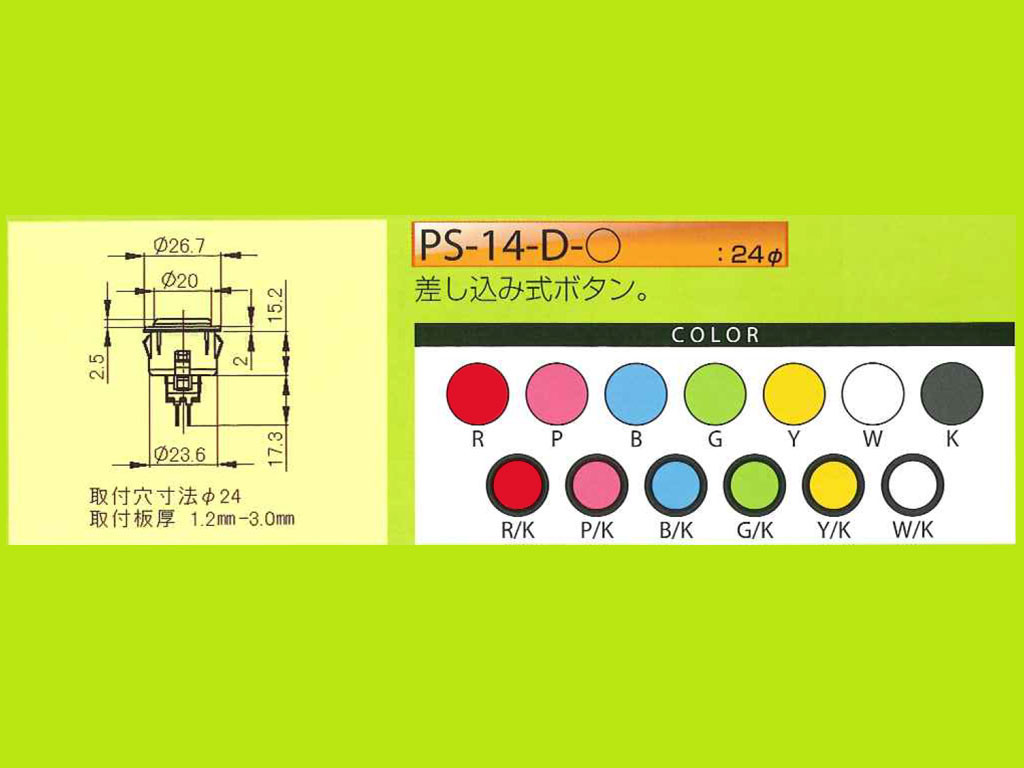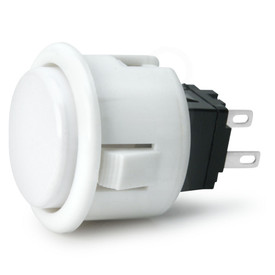- Category
- What's New?
- FightSticks/Pads
- Joysticks
- Pushbuttons
- Spare Parts & Tools
- Hardware & PCB
- Electrical
- Customize
- Merchandise
- Sales & Clearance
- Brand
Seimitsu PS-14-D 24mm Pushbutton Red
-
Product Description
Please measure your Fightstick Button Hole Before Purchasing PS-14-G/D
The Seimitsu PS-14-G and PS-14-D model has a slightly wider housing diameter, which makes it incompatible with a number of Fightsticks whose action button layout adhere strictly to the diameter of Sanwa's 29.5mm button housing
- PS-14-D 24mm housing diameter is 23.65mm
- PS-14-G 30mm housing diameter is 29.75MM
Please make sure your Fightstick's button holes have at least a +.25mm tolerance for the housing (29.75mm or more), or it will not fit.
The Seimitsu PS-14-D is a solid color 24mm pushbutton designed to snap into a thin (1.3mm or .051") metal panel. It has a noticeably flat plunger top, preferable to some who don't like the coonvex shape of other Japanese pushbuttons. This pushbutton is available in 7 colors, along with with a black rim/color plunger variation in 6 colors. The PS-14-D uses the Seimitsu PS-14-D Button Micro Switch. Please see our product photo gallery for full specs.
24 vs 30mm When processing orders, a frequent mistake we found among new players is choosing the wrong size for action buttons, such as punch and kick.
Within the fighting game genre, Japanese arcade buttons commonly consist of two diameter sizes: 24 millimeter and 30 milllimeter (mm). In most configurations, 30mm represents your action button. These are front facing, appearing most prominent on your Fightstick control panel. Option button, such as "Start", "Select", or more recently "Option", "Touch", or "Share" are usually 24mm.
UPDATE: Owners of Neo Geo AES Joysticks will need 24mm pushbuttons instead of 30mm (Thanks SRK's DEZALB)
Below is a visual representation of a common Fightstick control panel. Throughout this article, we will mark 24mm in green, and 30mm in Orange.

Checking the Proper Size
 Another way that players can misinterpret the pushbutton size is by measuring the pushbutton plunger. Have a look at the diagram at right.
Another way that players can misinterpret the pushbutton size is by measuring the pushbutton plunger. Have a look at the diagram at right.The plunger - the part that you press down to represent an input - is 25mm or a bit smaller in most 30mm pushbuttons. Often this leads to the conclusion that one needs a 24mm button and not 30mm.
Similarly measuring the button rim can lead to confusion, as it is intentionally larger than the button hole it is placed in. You don't want to use these measurements. Instead, review the button housing diameter, or the hole the button will be placed in. You can do this with a caliper - a digital caliper is often quite helpful for this and other arcade-related projects.
Control Panel Configuration
Most Fightsticks from MadCatz, Hori, Qanba, and similar will use these two sizes. How the buttons are used will depend on the model joystick that you own. Over time, we'll provide example configurations for specific popular Fightstick models and arcade cabinets using the color key for 24mm (green) and 30mm (orange). We'll also expand the key for future models if another size is introduced, and we offer for sale.




-
Product Reviews
-
Fabulous Hitbox Alternatives
I needed an alternative to the sensitive Sanwa buttons that came stock on my Hitbox and sprung for the Seimitsus. The additional resistance they provide feels great to me, and now I can also rest my hand on the box without accidentally depressing the buttons. One thing to note is that Seimitsu's red color is slightly more orange than Sanwa's. It might be difficult to notice without a side-by-side comparison, though; they look just fine and still match the Hitbox color scheme well enough.
I don't know about other boxes, but when I installed these in my Hitbox at least, while they fastened into place just fine, they were also easy to push out without having to press in on the tabs. That might make some people uncomfortable, but I've never had them pop out unintentionally while playing. If anything, it made the process of reinstalling them much easier.
Each button has a sort of top and bottom; from one side, you can kind of see -under- the button, and the orientation does change the way the button feels somewhat, so I had to open it back up and twist them all to face the same direction for a consistent look and feel. This is by no means a negative; if anything, it's nice to know that you can easily make subtle tweaks to the way they feel. Lex on Dec 18th 2018
-
-
Find Similar Products by Category










